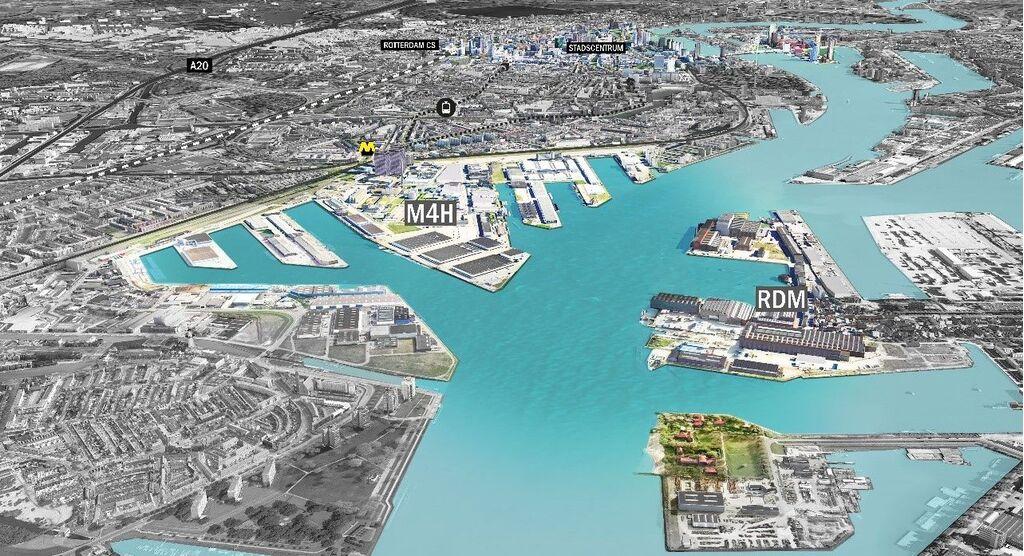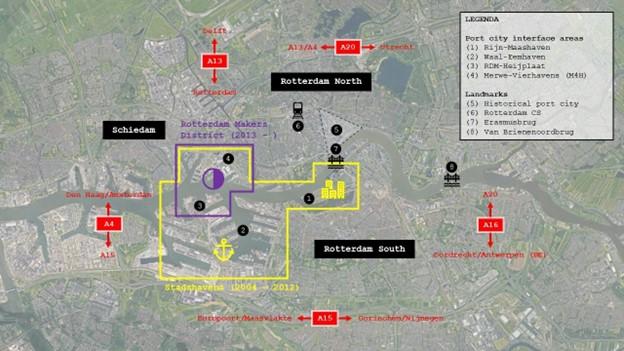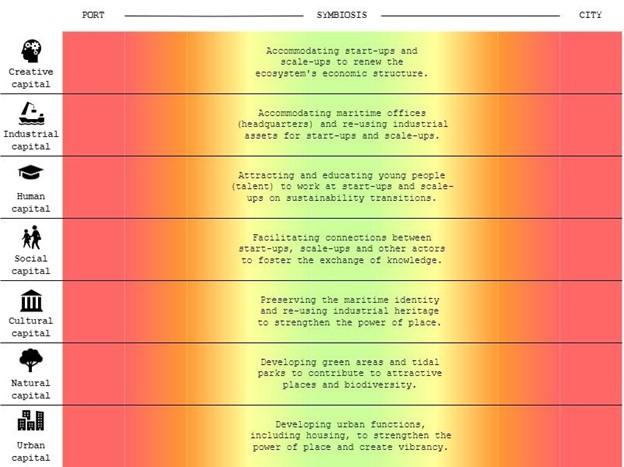Kees Stam

As redeveloped waterfront areas are among the most attractive spaces in Western port cities, urban actors, including citizens, often view the spatial ‘port city interface’ from an urban perspective, and expect port activities to leave and make way for urban functions such as housing, recreation and cultural amenities. This urban perspective can also be found in the AIVP Agenda 2030, where Commitment no. 8 on the port city interface is dedicated to residents living in the proximity of ports. At the same time, researchers have also described the port city interface as a strategic asset to restore the historical symbiotic relationship between ports and cities. In this blog, researcher Kees Stam explores how the port city interface in Rotterdam contributes to ‘port city symbiosis’, and argues that continuous collaboration between ports and cities is necessary for mobilising the potential contribution of the port city interface to port city symbiosis.
Port City Symbiosis and the Port City Interface
Recently, Jansen and Hein (2023) developed a framework to view port city territories as ‘ecosystems’, as those territories are challenged by multiple sustainability transitions taking place simultaneously (e.g., renewable energy, raw materials, circularity). Taking care of an ecosystem is a collective task of ports and cities, as ecosystems flourish by means of a symbiotic relationship between ports and cities (Daamen & Vries, 2013; Jansen & Hein, 2023). To achieve port city territories that are ecologically, socially and economically sustainable, the sustainability agendas of ports and cities therefore need to be integrated (Carpenter & Lozano, 2020). Against this background, the spatial port city interface is often described as a strategic asset in port city territories to explore new institutional arrangements, new economic orientations and novel land-use combinations (Daamen & Louw, 2016; Daamen & Vries, 2013; Witte et al., 2018). The port city interface thus provides a starting point for ports and cities to collaborate and learn, and to further explore how the symbiotic relationship between ports and cities can be restored. However, the port city interface often highlights existing land-use conflicts between ports and cities as well (Wiegmans & Louw, 2011; Van den Berghe et al., 2022). The challenge for ports and cities is thus to overcome conflicts, in order to turn the port city interface into a source of collaboration and learning (Pagés-Sánchez & Daamen, 2020).
Six Layers of Capital
Jansen and Hein’s framework takes “a ‘capital’ perspective on the ecosystem, in the sense that the ecosystem is rich in resources [...] like in natural ecosystems” (2023, p. 216). Their framework distinguishes six layers of capital that are available within the ecosystem. ‘Creative capital’ refers to start-ups and scale-ups that are the ecosystem’s future economic backbone. ‘Industrial capital’ refers to the existing economic structure, including industrial assets such as buildings and infrastructure. ‘Human capital’ refers both to the port’s traditional workforce, and to the talent that is needed to address sustainability transitions in the ecosystem. ‘Social capital’ refers to maritime networks and the connections between individuals and organisations. ‘Cultural capital’ refers to the ecosystem’s maritime identity and its industrial heritage. Finally, ‘natural capital’ refers to protecting the river delta, and to averting the negative externalities of port activities. Nurturing those layers of capital contributes to port city symbiosis, while neglecting those layers eventually leads to a parasitic relationship between ports and cities.
Rotterdam’s Port City Interface
In Rotterdam, ‘the port’, represented by the Port of Rotterdam Authority, and ‘the city’, represented by the City of Rotterdam, have been planning and developing the contemporary port city interface for twenty years already. In the first period, the port and the city tried to avoid land-use conflicts by dividing the port city interface into areas for port development and areas for urban (re)development. Port development has included the replacement of heavy port activities with maritime offices to improve the liveability in surrounding neighbourhoods, ensuring the port’s licence-to-operate. Urban development has had a focus on re-using the water for floating buildings and communities (Frantzeskaki et al., 2014). Simultaneously, the port and the city became increasingly aware of the shared challenge to renew the ecosystem’s fossil fuel-based economic structure (Bosman et al., 2018). This led to a second period of planning and developing the port city interface in which the port and the city are together developing ‘Rotterdam Makers District’ (Jansen et al., 2021; Stam & Peek, 2022). Figure 1 illustrates the two different planning periods in Rotterdam’s port city interface.

In Rotterdam Makers District, the port and the city are re-using the port city interface as a focal point within the ecosystem to accommodate innovative manufacturing start-ups and scale-ups that work on the energy transition, the circular economy and smart mobility. The port city interface is thus used as a living lab to address the multiple sustainability transitions that challenge the ecosystem. In the port city interface, start-ups and scale-ups find the physical and environmental space for their activities, while the proximity of the city makes them attractive employers for the talent that they need and that is available in the city. The next generation of port companies reactivates the industrial assets that are leftovers of the ecosystem’s old economic structure. The connections and networks between companies, research and educational institutes, incubators, etc. are important to facilitate and foster knowledge exchange. The intention of Delft University of Technology to open a new campus in Rotterdam can possibly be an accelerator for the development of Rotterdam Makers District too. The maritime identity and industrial heritage, as well as green areas, including tidal parks, all contribute to the power of the place.
The six layers of capital from Jansen and Hein’s framework on port city symbiosis are in Rotterdam all tied to re-using the port city interface to accommodate innovative manufacturing start-ups and scale-ups. However, if applied to the port city interface, the framework lacks the urban perspective that this blog started with, in the sense that housing, restaurants, coffee bars, recreation, cultural amenities, etc. are also important ingredients of successful innovation districts (Katz & Wagner, 2014). The development of Rotterdam Makers District for instance also includes the construction of 3400 to 5100 housing units until 2035 in Merwe-Vierhavens, on the north bank of the Meuse river. Thus, a seventh layer of ‘urban capital’ can be added to Jansen and Hein’s framework. There is not a single definition of urban capital, but in the context of the port city interface it refers to the urban amenities that contribute to the ‘local buzz’ (Bathelt et al., 2004). Figure 2 illustrates how the different layers of capital are nurtured in Rotterdam’s port city interface.

Conclusion
This blog addresses the question how the spatial port city interface can contribute to a symbiotic relationship between ports and cities. In Rotterdam, the port city interface is being used to build a cluster of innovative manufacturing start-ups and scale-ups. Such a manufacturing cluster is crucial for working on sustainability transitions to renew the ecosystem’s fossil fuel-based economic structure. The port city interface is a strategic asset because it offers unique opportunities: innovative manufacturing start-ups and scale-ups need to be embedded in the urban fabric to have access to knowledge and talent, which can only be achieved in areas where port and city meet. Residential development and social challenges need to be integrated with developing a manufacturing cluster (Jansen et al., 2021; Stouten, 2017), showing the importance of making connections between the different layers of capital in the port city interface.
This also requires a change in traditional views on waterfront redevelopment: an economic perspective on the port city interface is, for example, absent in the AIVP Agenda 2030. On the opposite, a layer of urban capital is missing when Jansen and Hein’s framework on port city symbiosis is applied to the port city interface. Therefore, further exploration of innovation districts in port cities is promising, as innovation districts establish a link between economic/port and urban development (Katz & Wagner, 2014). To conclude on a critical note: the case of Rotterdam also shows that, even with shared ambitions between ports and cities, the different layers of capital can still cause conflicts between ports and cities, and overcoming those institutionalised conflicts is not easy (Pagés-Sánchez & Daamen, 2020). Therefore, it is only through continuous collaboration and learning between ports and cities that the port city interface can be mobilised to truly contribute to port city symbiosis.
Acknowledgement
Kees Stam is PhD Candidate at Delft University of Technology, working on learning in the context of sustainability transitions in port cities, and is researcher and lecturer at Rotterdam University of Applied Sciences.
This blog has been written in the context of discussions in the LDE PortCityFutures research community. It reflects the evolving thoughts of the author and expresses the discussions between researchers on the socio-economic, spatial and cultural questions surrounding port city relationships. This blog was edited by the PortCityFutures editorial team: Maurice Jansen and Vincent Baptist.
References
AIVP (n.d.). AIVP Agenda 2030: 10 Goals for Sustainable Port Cities. Le Havre: AIVP.
Bathelt, H., Malmberg, A. & Maskell, P. (2004). Clusters and Knowledge: Local Buzz, Global Pipelines and the Process of Knowledge Creation. Progress in Human Geography, 28(1), 31-56.
Bosman, R., Loorbach, D., Rotmans, J. & Van Raak, R. (2018). Carbon Lock-Out: Leading the Fossil Port of Rotterdam into Transition. Sustainability, 10(7), 1-20. https://doi.org/10.3390/su10072558
Carpenter, A. & Lozano, R. (2020). Proposing a Framework for Anchoring Sustainability Relationships between Ports and Cities, in: A. Carpenter & R. Lozano (eds.), European Port Cities in Transition, Springer, 37-51.
Daamen, T. A. & Louw, E. (2016). The Challenge of the Dutch Port-City Interface. Journal of Economic and Human Geography, 107(5), 642-51. https://doi.org/10.1111/tesg.12219
Daamen, T. A. & Vries, I. (2013). Governing the European Port-City Interface: Institutional Impacts on Spatial Projects between City and Port. Journal of Transport Geography, 27, 4-13. https://doi.org/10.1016/j.jtrangeo.2012.03.013
Frantzeskaki, N., Wittmayer, J. & Loorbach, D. (2014). The Role of Partnerships in ‘Realising’ Urban Sustainability in Rotterdam’s City Ports Area, The Netherlands. Journal of Cleaner Production, 65, 406-17. https://doi.org/10.1016/j.jclepro.2013.09.023
Jansen, M., Brandellero, A. & Van Houwelingen, R. (2021). Port-City Transition: Past and Emerging Socio-Spatial Imaginaries and Uses in Rotterdam’s Makers District. Urban Planning, 6(3), 166-80. https://doi.org/10.17645/up.v6i3.4253
Jansen, M. & Hein, C. (2023). Port City Symbiosis: Introduction to the Special Issue. Maritime Economics & Logistics, 25, 211-29. https://doi.org/10.1057/s41278-023-00257-x
Katz, B. & Wagner, J. (2014). The Rise of Innovation Districts: A New Geography of Innovation in America. Washington DC: Brookings. https://www.brookings.edu/wp-content/uploads/2016/07/innovationdistricts1.pdf
Pagés-Sánchez, J. M. & Daamen, T. A. (2020). Governance and Planning Issues in European Waterfront Redevelopment 1999-2019, in: A. Carpenter & R. Lozano (eds.), European Port Cities in Transition, Springer, 127-48.
Stam, K. & Peek, G-J. (2022). Successes and Challenges in Developing Rotterdam Makers District. PORTUS, 44. https://portusonline.org/successes-and-challenges-in-developing-rotterdam-makers-district/
Stouten, P. (2017). Gentrification and Urban Design in the Urban Fabric of Rotterdam. Journal of Urban Regeneration & Renewal, 11(1), 92-103.
Van den Berghe, K., Louw, E., Pliakis, F. & Daamen, T. (2022). When “Port-out – City-in” Becomes a Strategy: Is the Port-City Interface Conflict in Amsterdam an Observation or a Self-fulfilling Prophecy? Maritime Economics & Logistics, 25, 330-50. https://doi.org/10.1057/s41278-022-00236-8
Wiegmans, B. & Louw, E. (2011). Changing Port-City Relations at Amsterdam: A New Phase at the Interface? Journal of Transport Geography, 19(4), 575-83. https://doi.org/10.1016/j.jtrangeo.2010.06.007
Witte, P., Slack, B., Keesman, M., Jugie, J-H. & Wiegmans, B. (2018). Facilitating Start-Ups in Port-City Innovation Ecosystems: A Case Study of Montreal and Rotterdam. Journal of Transport Geography, 71, 224-34. https://doi.org/10.1016/j.jtrangeo.2017.03.006
